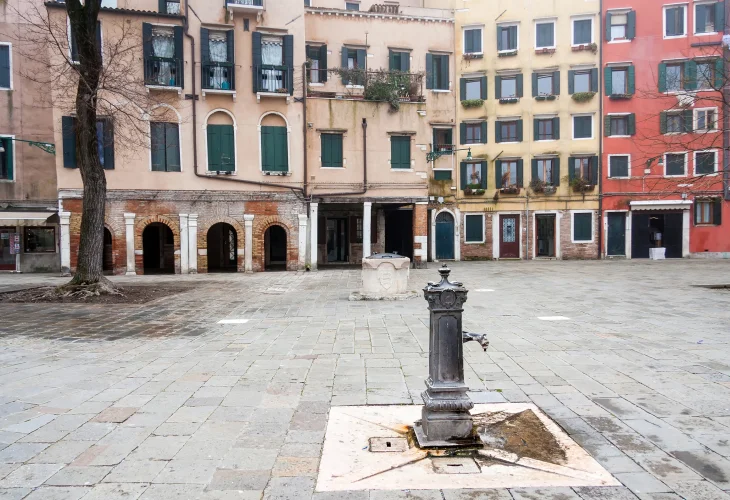The Venetian Ghetto: Limits and Cultural Growth
Life in the Venetian Jewish ghetto was densely packed. As the community expanded, the space became increasingly restricted. Residents lived in cramped apartments, and the streets were crowded and bustling.
 The Jewish Quarter in Venice (Photo: Shutterstock)
The Jewish Quarter in Venice (Photo: Shutterstock)When we think of Venice, images of a picturesque, beautiful city come to mind, with gondolas gliding through blue canals beneath idyllic bridges, surrounded by ancient, grand buildings. A visit to Venice, steering through the maze of canals toward the north in the Cannaregio area, reveals a shift from the magnificent Venetian architecture to more humble, crowded buildings. There, at Campo del Ghetto Nuovo, lies the central square of the Venetian Jewish ghetto.
For Jews, the word 'ghetto' often conjures the harshest and most oppressive ghettos of the Nazis. However, the Nazis were not the inventors of ghettos; the Italians created them. Not only did they establish ghettos, but also the infamous yellow badge—these were Italian innovations, not German. Despite the oppressive intent of the Italians to restrict and control Jews, in retrospect, these ghettos played an essential role in preserving Jewish culture. In this series, we explore the significant and influential ghettos of Europe, examining their origins, purposes, and the unique characteristics of each.
The Jewish community in Venice is one of Europe's oldest, with records dating back to the tenth century. Over time, Jews in Italy, particularly Venice, enjoyed a comparative degree of freedom. Despite being forced to wear a yellow badge and facing numerous restrictions and discriminations, Jews were allowed to work in various professions. They engaged in commerce, medicine, pharmacy, and printing, integrating well into the Italian economy.
Jewish status in Europe was never secure. They lived in constant tension with the Church, which continuously sought ways to curtail Jewish freedoms, and with artisan guilds—professional associations that feared Jewish economic success could overshadow "good and honest Christians." These guilds leveraged their influence to keep Jews out of the most lucrative trades, confining them to professions requiring special expertise or those less profitable.
In Italy, as elsewhere in Europe, Jews faced persecution and discrimination. In Venice, Jews were not recognized as citizens and were banned from living freely. Additionally, they had to pay a special tax.
Following the expulsion from Spain and Portugal, many Sephardi Jews relocated to Italy and Venice, significantly increasing the Jewish population there. By 1509, Venetian military defeats drove many refugees, including 5,000 Jews from Spain and Portugal, to the central Venetian islands. Soon, demands arose for the Jews to be expelled. Encouraged by sermons from monks, Venetian citizens began pressing authorities to tighten restrictions on the Jews.
In 1516, responding to pressure, Venetian authorities confined the Jewish community to a separate, walled area called the "Ghetto Nuovo," meaning "new foundry," named after a foundry once located there. The ghetto was turned into an isolated island by surrounding canals and high walls.
With their move into the ghetto, authorities imposed strict restrictions on the Jews. They were not allowed outside the ghetto after midnight. Christian guards manned the gates to enforce this curfew, and their wages were paid by the Jews. Additionally, Jews had to fund the construction and maintenance of nearby churches as part of the heavy taxes imposed on them. They were barred from most professions, except for medicine, trade, money lending, and dealing in second-hand clothing, and had to pay perpetual rent for their properties.
Initially, Spanish Jews were not required to live in the ghetto. Being wealthy and influential merchants, authorities wanted to benefit economically from them, so the ghetto was primarily for German and Italian Jews. However, in 1541, all of Venice's Jews were forced to reside in the ghetto, which was expanded with a new section called the "Ghetto Vecchio," meaning "old ghetto."
Life in the ghetto was extremely crowded. The community grew continuously, but space was limited. Jews lived in small, cramped apartments, and the streets were dense with activity and people.
Despite the restrictions and decrees, the Jewish community thrived within the ghetto. The limitations provided Jews with complete separation from non-Jews, fostering a vibrant community life. Inside the ghetto, Jews established schools, synagogues, and yeshivas without interference. Renowned rabbis such as Rabbi Shmuel Katzenellenbogen, author of "Korban Shmuel," served as the city's chief rabbi and head of one of Europe's most important yeshivas. Likewise, Rabbi Judah Aryeh of Modena led the Venetian yeshiva. Venice was also home to the first Jewish printing press, where the Talmud and Rabbi Yosef Karo's Shulchan Aruch were first printed.
The Venetian ghetto marked a new era in Jewish history, a time when Jews were somewhat shielded from external influences. Isolated and insulated in the ghetto, they could dedicate themselves to Torah studies while maintaining a strict Jewish lifestyle. Ultimately, the ghetto was a blessing for Jews, transforming a curse into a blessing.

